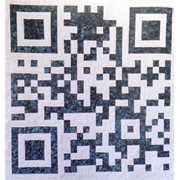Here is how I do it.
1. Choose your letters and cut them out. Lay your letter down on your fabric.
Here is my letter "C," atop my color fabric. Since this is reverse appliqué, the letter C will be in white, underneath this light blue batik. But you draw the outline on the top fabric, which, counter-intuitively, is actually called the "background fabric!" Yes, this is reverse appliqué, and the background fabric is on the top. I am using a purple air-soluble marker.
2. Here it is, all outlined.
If you're smart - not like me, I always forget this step! - you'll now make a small clip somewhere inside the letter, so that after you've got it sewn down and you want to trim away the batik to let the white show through, you'll have a wee hole to start with. I always forget to do this, which means that later on I have to struggle to separate my layers.
3. Now I put my white fabric onto some lightweight fusible stabilizer. I iron the stabilizer to the back of my white fabric, and I used a teflon pressing sheet over it.
There are three layers here - the fusibe, which I'm folding a bit with my thumb to show it, the fabric, a white-on-white print, and then up there by my middle finger is the teflon sheet.
The reason I'm sticking it to fusible is to waste less of my white fabric, because it will be cut of and discarded. With the white fabric attached to the fusible, I can put it in a hoop to do the sewing. I have done it without a hoop and don't recommend it. Nice even tension in a circle all around the letter works best.
4. Here we are all hooped and ready for the first stitching.
I set my stitch length very small - the setting on my machine says 1.2. One-point-two what I'm not exactly sure, but here it is seen from the back.
And here it is next to a ball point pen so you can see the scale.
5. Now you have to clip away the part of the "background" fabric (blue batik) that's covering the white fabric, trimming as close as you can to the fine stitching. (And here's where it would have been helpful to have made that little snip at step 1!)
Once it's all clipped, back into the hoop we go for the satin stitching.
6. The satin stitching needs to be wide enough to cover the line of stitching and the cut edges of the fabric. A lot of people make it too tight though.
I have to say, not bad for a camera phone! Anyway, there's the line of tiny stitches, and you can see the needle and about three of the zig-zag satin stitches. You've covering the stitching and the cut edges.
Satin stitching done...
7. Now it's time to trim away the excess white fabric.
You'll notice I'm holding my "background" blue batik fabric away while I cut. Be careful, or you'll end up having to start all over!
You can then neaten everything up on the back side, make all the allowances even.
And there you have it, all ready for a nice press.


















